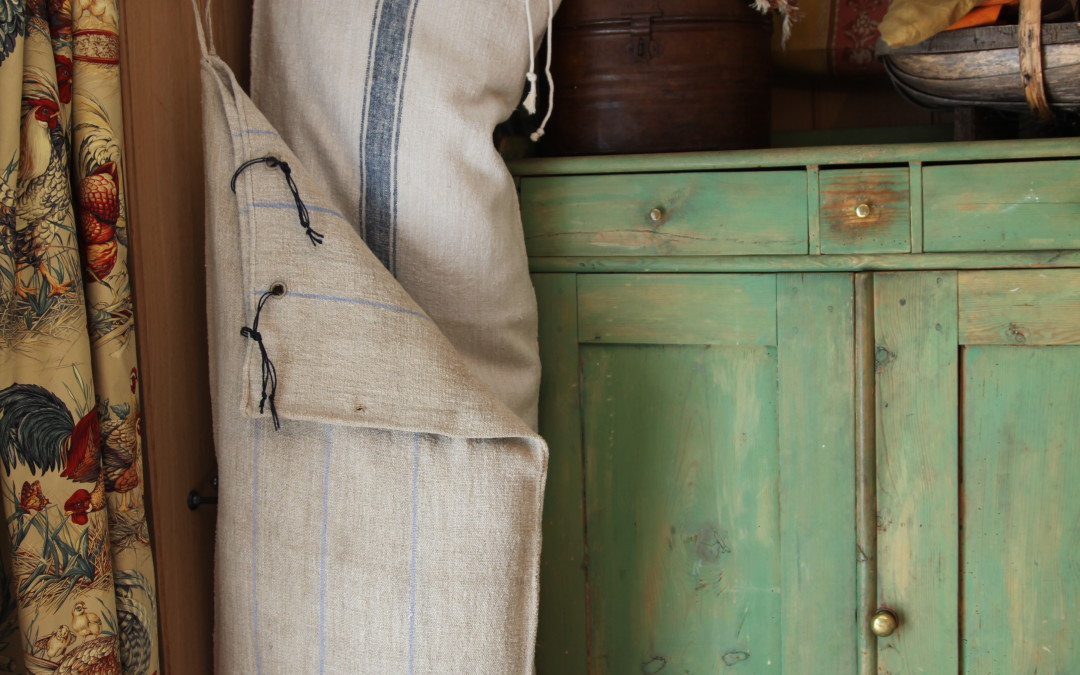Sometimes the most unassuming things in life make the best creations..
I love this new project – flour sack cushions – because you can use them anywhere, they look great all around the house, and outside too – we use them as garden pillows as they are just perfect for lazing around on a summers afternoon. Or they work really well as sofa back pillows, or soft bed heads, all year round. The sizes vary – not much, but enough that the bigger ones are particularly handy in playrooms and nurseries, as a stylish, homemade substitute for beanbags.
If you frequent antique shops and vintage fairs, you may be familiar with these grain sacks, or ‘feed sacks’ that come from France, and throughout middle and Eastern Europe – the hand woven hemp sacks that carried flour and grain to and from markets. These are all made of natural fibres – the colours, textures and thickness bear witness; the width of stripes or makers stamp is entirely dependent on which corner of the globe they come from, and the hand of the weaver that created them. Their original uses may have declined, but in the true nature of re-cycling they have become both style and comfort assets to many other households, including mine.
The more ‘vintage’ and niche they are, and the rarer the colours or weaves, the more they will cost – and that’s fine, because some really are better, far more pleasing, than others. There are poorly woven ones for sale and machine stitched ones that you’ll need to avoid.
Find the best, and then value them- they won’t be made any more. The ones I have used are beautifully woven and coloured, they are simple but very well made.
It may be comforting to hear that these Flour Sack Pillows require very little skill and effort to make – most of the work has already been done by the original maker, who spent many long hours weaving, and then many more in stitching the tiny stitches that make grain-proof seams. Try unpicking one- it takes a very long time !
Whilst they are robust and can withstand the rough and tumble of a busy life, excessive washing and tumble drying can damage them ( I know because I’ve sadly ruined some…) so it’s really best to leave them out to dry- in sunshine and breeze. Above all, the beauty of the hand woven fibres that makes these sacks is that they become softer with age, especially those made from hemp, so they are always comfy to laze around on (but also difficult to peel yourself away from..)
There are several options for the ties that both close the ends and are used to hang them up – including shoestrings, piping cord, linen thread and garden twine. There are no rules on which to use, and when we have threads from a damaged sack or one we’ve cut down we prefer to plait these to make a strong, self – fabric tie.
If you can’t seem to get your hands on these, there are some really good specialist suppliers in every country – similar to Parna and Beyond France in the UK. But do also look online – you can always find them (in bulk or singularly) on sites such as Amazon or eBay – but do be careful with the quality.
The golden coloured hessian coffee sacks that still criss-cross the world with coffee beans are another good source of natural fibre sacks – these are not as soft and not handmade, so have less uses perhaps, but are more plentiful and relatively inexpensive for lounging- around cushions, such as these.
To download this project for free, from our online store click here. https://designandmake.net/product/flour-sack-pillows/

